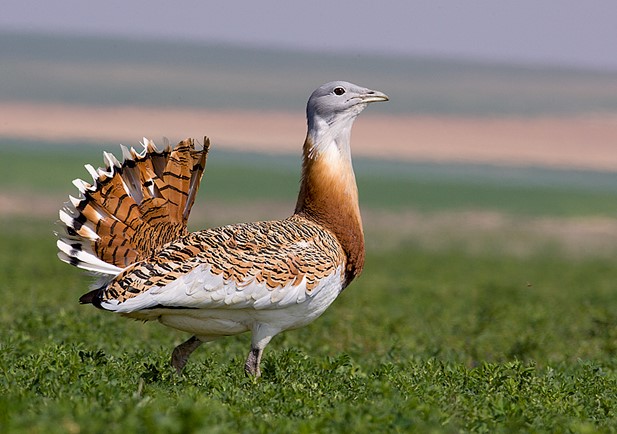The Strategy for the Conservation of Endangered Birds Associated with Agricultural and Steppe Environments in Spain is the one that establishes the guiding criteria and guidelines for the conservation of steppe birds and associated with agricultural environments. especially for those in an unfavorable conservation status.
They are considered steppe birds those that can use stapic agents throughout their life cycle. Furthermore, with a few exceptions (little kestrel, wheatear or roller), these species have the property of nesting in small bushes or directly on the ground.
The decline of steppe birds is direct result of the transformation of grasslands and crops extensive rain-fed herbaceous crops in new intensive agricultural systems, a process that has been taking place in Western Europe since the mid-20th century and continues in the early decades of the 21st century.


Reducing the decline of agricultural birds is one of the objectives of the Green Architecture Measures of the Common Agricultural Policy (CAP), specified in Spanish CAP Strategic Plan 2023-2027 (PEPAC). A research team led by the National Museum of Natural Sciences (MNCN-CSIC) has evaluated Spanish proposals to comply. This research, published today in Ardeola, This shows that the adopted measures would have an average potential effectiveness between 31% and 42%, depending on the autonomous community and the type of crop, in birds. According to the study These results could be substantially improved with specific adjustments to the plan.
Spain is home to the greatest diversity of agricultural birds in the European Unionand knowledge about their responses to agricultural practices has recently been revised. This has made it possible to determine to what extent PEPAC includes this knowledge in the preliminary evaluation of its potential effectiveness. The PEPAC includes 204 measures whose aim is to benefit birds, four at national level for application by the majority of farmers and with very general objectives to improve the agricultural landscape, and 200 rural development measures proposed by each autonomous community for specific types of crops, and with more specific objectives such as improving the habitat of endangered steppe birds.


Birds need more protection
“Behind the decline of agricultural birds lies the decline of the ecosystems in which they live. So if we take measures that allow these species to thrive, we will improving the environmental situation of the entire ecosystembecause it is the deterioration of the environment that is driving the decline of the population,” he explains the researcher specialized in landscape ecology Elena D. Concepción.
The four national measures – ban on burning and plowing of grasslands, maintenance of undeveloped strips on the banks of aquatic environments, and maintenance of between 4% and 7% of each field is undeveloped or fallow– They take the form of payments to the majority of farmers, and are said to achieve an effectiveness of between 50% and 60%.
Rural development measures, such as specific measures to conserve groups of birds, the maintenance of traditional uses or support for apiaries, would have highly variable efficiencies, between 0% and 50%, depending on the crop type. On average, they would not reach 30% in any autonomous community. By combining the national and regional results, final results are obtained that, depending on each autonomous community, range from 31% to 42%.
“The limited use of scientific evidence for the design of PEPAC reflects its low environmental ambition and compromises its effectiveness in achieving its objectives,” he warns. Mario Díaz, MNCN researcher. An important objective to maintain adequate agricultural landscapes to make agricultural production compatible with ecosystem health is to ensure that at least 10% of these landscapes consist of uncultivated areas.necessary for the rest of the Earth and connectivity between ecosystems. “Despite its relevance and the relative simplicity of its implementation, the Spanish Strategic Plan does not guarantee this objective,” laments researcher Pablo Pérez Pozuelo.
“To solve these problems the elements of green architecture must be integrated –conditionality, eco-regimes and rural development measures–, taking into account the different levels at which the country’s government is organized, to promote complex or mosaic landscapes in which built-up areas coexist with semi-natural areas. “In summary, scientific knowledge must be integrated and, in addition to production, also value the ecosystem services provided by agroecosystems and we specified that by assessing the situation of the birds,” says Concepción.
“What emerges from this analysis is that the effectiveness of the measures that are implemented are likely to be low because their fit with the conservation needs of agricultural birds is poor.. In addition, the lack of integration between the different levels of government makes it difficult to make the most of the elements of green architecture to achieve the objectives that Spain has promised to justify the funds provided by the CAP,” concludes Díaz.
He team responsible for this evaluation coordinates the Interdisciplinary Thematic platform AGRIAMBIO and it is within this framework that the research was conducted. Pérez Pozuelo, P., Concepción, ED Azcárate, FM, Bota, G., Brotons, L., García, D., Giralt, D., López-Bao, JV, Mañosa, S., Morales, MB, Navarro, A., Olea, P.P., Peco, B., Rey, P.J., Seoane, J., Suárez-Seoane, S., Schöb, Ch., Tarjuelo, R., Traba, J., Valera, F. and Díaz M. (2024). Ex ante evaluation of a multi-level CAP strategic plan for the conservation of farmland birdsN.

